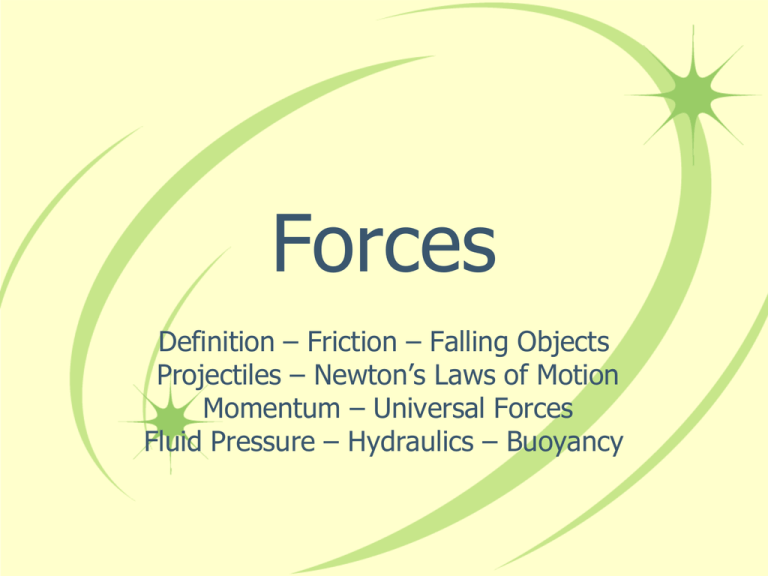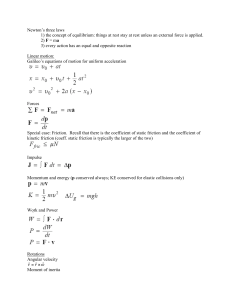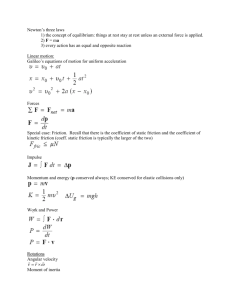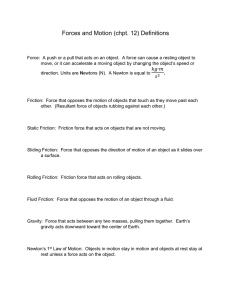Definition – Friction – Falling Objects Projectiles – Newton`s Laws of
advertisement

Forces Definition – Friction – Falling Objects Projectiles – Newton’s Laws of Motion Momentum – Universal Forces Fluid Pressure – Hydraulics – Buoyancy Definition of Force • Force = a push or pull that causes a change in the motion of an object. – – – – – Change may be in speed or direction Act in a certain direction (vector) Can be shown using a Free Body Diagram Forces transfer/transform energy Unbalanced forces change motion, balanced forces do not. • Measured in Newtons, N (1 N = 1 kg·m/s2) Friction • A force that opposes the movement of objects that touch each other. • 4 main types – Static friction – resists motion from rest – Sliding friction – continues to resist motion as an object is sliding over a surface – Rolling friction – friction of an object on wheels, ball bearings, or rollers – Fluid friction – resists movement of an object through a fluid (air, water, other liquids) Comparison of Friction Types •Static •Sliding • Rolling • Fluid Falling Objects • • • • Accelerate due to force of gravity. Acceleration on Earth is at a rate of 9.8 m/s2 Air resistance (friction) increases with speed. Objects reach a terminal velocity when the force of gravity is opposed by air resistance. Projectile Motion • Projectiles experience a horizontal force and the force of gravity. • This leads to a curved path of motion. NO MORE VEGGIES! Newton’s 1st Law of Motion • The Law of Inertia – The motion of an object remains unchanged unless acted upon by an unbalanced force. • An object in motion stays in motion and an object at rest stays at rest, unless acted upon by an unbalanced force. Newton’s 2nd Law of Motion • The acceleration of an object is equal to the net force acting on it divided by the object’s mass. • F=ma – Or a = F/m or m = F/a Weight vs. Mass • Weight = the force of gravity acting on the mass of an object – If F = ma then W = mg – W is weight in Newtons – m is mass in kilograms – g is acceleration due to gravity, m/s2 Newton’s 3rd Law of Motion • Action-Reaction • Whenever one object exerts a force on a second object, the second object exerts an equal and opposite force on the first object. • List 3 examples in your notes from your textbook (page 373) or from class discussion. Momentum • Momentum = mass x velocity – The larger the object and the faster it is moving, the more momentum it has • Similar to force, but with only velocity instead of acceleration Conservation of Momentum – The total momentum of a closed system remains the same before and after collisions – For a collision between objects A and B . . . (MomentumA)before + (MomentumB)before = (MomentumA)after + (MomentumB)after (mA x vA)before + (mB x vB)before = (mA x vA)after + (mB x vB)after – Elastic collisions (objects hit & bounce apart with no friction or loss of momentum) – Inelastic collisions (objects stick together) Electromagnetic Force • Can Attract or Repel • Opposite charges attract, Like charges repel • Moderate strength over medium distance Nuclear Forces • Strong and Weak Nuclear Forces • Forces inside the nucleus of an atom that hold it together or play a role in its decay • Very strong, but only over short distances (like the size of a proton or so) Gravitational Force • Newton’s law of Universal Gravitation – Any two objects in the universe have a force of gravitational attraction between them – Affected by the mass of the objects and the distance between them – Weakest force but acts over very long distances Centripetal Forces • Describes any force that is center directed • Acts to change the direction of motion of an object to keep it in “orbit” • NOT Centrifical or Centrifugal Pressure • Definition: Force per unit of area • Equation: P = F / A • Units: if F is in Newtons and A is in m2, then P is in Pascals – Pascals are really small units of pressure, so we often use kilopascals or kPa – (1 kPa = 1000 Pa) – Other units (like psi, atm, torr, mmHg, bar, in. can all be converted into kPa) Pressure in Fluids • Pascal’s Principle – Pressure on a fluid is transmitted equally and unchanged in all directions throughout the fluid. • Application : Hydraulics – Piston systems are the simplest Hydraulics F= 100 N F= F=1000 ?N N A= 1 m2 P= P= P=100 F/A ? Pa /1 Pa A= 10 m2 100 =/FFA/Pa / 10 10 100 P= P= F= 100 x10 x10 Seems like a magical way to multiply force. What’s the catch? Bernoulli’s Principle • As the speed of a fluid increases, the pressure within the fluid decreases 2 important applications – Wings and lift – Atomizers, aspirators, spray bottles Airplane Wing Lift & Wings Atomizer • Perfume atomizer Hose-end sprayer Atomizers Archimedes’ Principle • The buoyant force on an object is equal to the weight of the fluid displaced by the object – Pressure increases with depth in a fluid – Upward force due to pressure on the bottom of an object is greater than the downward force due to pressure on the object Buoyancy • Buoyant force = the weight of the fluid displaced Floating and Sinking • Buoyant force > Weight of the of the object the object floats • < Weight the object sinks Buoyant force of the object, Floating and Sinking Density • Density = mass / volume (D=m/V) – Units for density depend on the units for mass and volume. • kg/m3 • g/cm3 • g/mL • g/L Density • It measures how compact the matter is in an object • Density can also be used to predict if an object will float or sink in a fluid – If Dobject < – If Dfluid the object will float Dobject > D fluid the object will sink • Average density is important! Density Benchmarks • Density of pure water at 4°C (near freezing) is exactly 1 g/mL • Density of pure water at 20°C (room temp.) is 0.9982 g/mL (close enough to 1 for our purposes) • Density of air (at sea level, at 20°C) is approximately 1.2 kg/m3 or 0.0012 g/cm3


